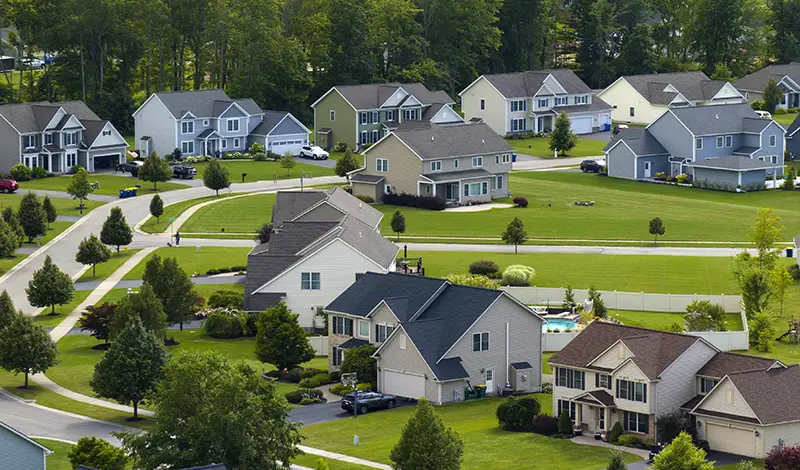Urban vs. Suburban Living
Published on July 3, 2024 | 7 Minute read

Melanie
Ortiz Reyes
Content Specialist
Deciding where to live is a big decision that impacts every aspect of your life, from your daily commute to your weekend activities. One of the fundamental choices you'll need to make is whether to live in an urban or suburban area. Both environments offer unique benefits and challenges, and the best choice for you will depend on your lifestyle, priorities, and long-term goals.

Urban Living: The Pulse of the City
Urban areas are characterized by their dense population, vibrant culture, and bustling activity. Cities are often the economic and cultural hubs of a region, offering a wide array of amenities and opportunities. For a list of cities we service, click here.
1. Convenience and Accessibility: One of the primary advantages of urban living is convenience. Cities are designed to be pedestrian-friendly, with many amenities within walking distance or a short public transit ride away. Grocery stores, restaurants, entertainment venues, and medical facilities are typically easily accessible, making daily errands simpler and quicker.
2. Public Transportation: Urban areas often boast extensive public transportation networks, including buses, subways, and trains. This can reduce the need for a car, saving on expenses like gas, insurance, and maintenance.
3. Employment Opportunities: Cities tend to have a higher concentration of job opportunities across various industries. The proximity to a wide range of employers can be beneficial for career growth and job mobility. Networking opportunities are also more abundant in urban settings.
4. Cultural and Recreational Activities: Urban areas are rich in cultural attractions, including museums, theaters, concert halls, and sports venues. The diversity of activities and events means there is always something to do, whether it's a new restaurant opening, a music festival, or an art exhibit.
5. Diverse Communities: Cities are often melting pots of different cultures, backgrounds, and lifestyles. This diversity can enrich your living experience, offering exposure to various cuisines, traditions, and perspectives. It can also foster a more inclusive and open-minded environment.
1. Cost of Living: The convenience and amenities of urban living come at a price. Cities tend to have a higher cost of living, with more expensive housing, groceries, and services. Renting or buying property in a desirable urban area can be particularly costly.
2. Space Constraints: Urban housing typically offers less space compared to suburban homes. Apartments and condos are common, often with limited outdoor space. This can be a drawback for families or individuals who value having a yard or more room to spread out.
3. Noise and Crowding: The hustle and bustle of city life can also mean more noise and less privacy. High population density can lead to crowded public spaces and longer wait times for services.
4. Pollution and Safety: Urban areas can have higher levels of pollution due to traffic and industrial activities. Safety can also be a concern, with higher crime rates in some city neighborhoods compared to suburban areas.

Suburban Living: The Comfort of the Suburbs
Suburban areas are typically located on the outskirts of cities, offering a more relaxed and spacious living environment. Suburbs are often characterized by residential neighborhoods, schools, and local businesses.
1. More Space and Larger Homes: One of the benefits of suburban living is the availability of larger homes and more outdoor space. Suburban homes often come with yards, gardens, and more square footage, which can be ideal for families or those who value space.
2. Quiet and Tranquil Environment: Suburbs are generally quieter and less crowded than urban areas. The lower population density can lead to a more peaceful and relaxed atmosphere, which can be beneficial for stress reduction and overall well-being.
3. Family-Friendly Amenities: Suburbs are often designed with families in mind, offering excellent schools, parks, and recreational facilities. The abundance of safe, open spaces for children to play and explore can be attractive for families with young children.
4. Sense of Community: Suburban living can foster a strong sense of community. Neighborhoods often have community events, local sports leagues, and social gatherings that can help residents build close-knit relationships with their neighbors.
5. Lower Cost of Living: While this can vary by region, suburban areas generally have a lower cost of living compared to urban centers. Housing is often more affordable, and everyday expenses like groceries and services can be less expensive.
1. Commute Times: One of the most common drawbacks of suburban living is the potential for longer commute times. If you work in the city, commuting from the suburbs can be time-consuming and stressful, especially if public transportation options are limited.
2. Dependence on Cars: Suburban areas are less likely to have extensive public transportation networks, making car ownership almost necessary. This can lead to higher transportation costs and a greater environmental impact.
3. Limited Cultural and Recreational Activities: While suburbs have their own amenities, they may not offer the same variety and frequency of cultural and recreational activities as urban areas. Residents may need to travel to the city for certain events or experiences.
4. Homogeneity: Suburbs can sometimes lack the diversity found in urban areas. This can lead to a more homogeneous environment, which might not appeal to everyone. It can also mean fewer options for diverse dining and cultural experiences.
5. Fewer Employment Opportunities: Suburban areas often have fewer job opportunities compared to urban centers. While remote work is becoming more common, those who need to be physically present at their workplace may find fewer options in the suburbs.

Finding the Right Fit
Ultimately, the decision between urban and suburban living comes down to personal preference and priorities. Here are some factors to consider when making your decision:
- Lifestyle: Think about what kind of lifestyle you want. Do you thrive in a fast-paced, dynamic environment, or do you prefer a quieter, more laid-back setting?
- Family Needs: Consider the needs of your family. Do you have young children who would benefit from a larger home and outdoor space, or are you looking for the convenience and amenities of city living?
- Work Commute: Evaluate your work situation and how much time you're willing to spend commuting. Proximity to your workplace can significantly impact your quality of life.
- Budget: Assess your budget and how much you're willing to spend on housing and daily expenses. Be realistic about what you can afford without compromising your financial stability.
- Long-Term Goals: Think about your long-term goals. Are you planning to settle down and start a family, or are you focused on career advancement and networking opportunities?
Both urban and suburban living offer distinct advantages and challenges. Whether you choose the vibrant energy of the city or the peaceful tranquility of the suburbs, the most important thing is to find a place where you feel happy, comfortable, and at home.